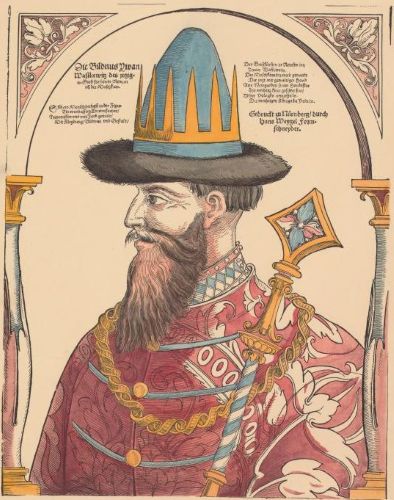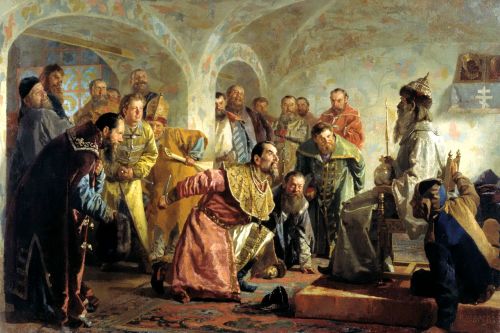

Like Ivan, Putin rose to power amid economic crisis and political disintegration.

By Matthew A. McIntosh
Public Historian
Brewminate
Introduction
As Russia continues its efforts to assert dominance on the world stage and reshape its domestic narrative, President Vladimir Putin has increasingly turned to the past for inspiration. Among the historical figures whose legacies Putin seeks to evoke, few are as controversial or symbolically potent as Ivan IV Vasilyevich—better known to the world as Ivan the Terrible. The legacy of Russia’s first tsar is one of ruthless consolidation, territorial expansion, centralization of power, and the forging of a distinctly autocratic Russian identity. In many ways, these themes resonate powerfully with Putin’s own vision of Russia’s future—and his understanding of its past.
The Legacy of Ivan the Terrible: A Tsar of Blood and Order

Ivan the Terrible ruled as Grand Prince of Moscow from 1533 and assumed the title of Tsar in 1547, marking the beginning of the centralized Russian autocracy. His reign was characterized by dramatic reforms, expansion into Siberia and the Volga region, and a brutal crackdown on the aristocracy and perceived traitors through the institution of the Oprichnina—a parallel state apparatus that terrorized the boyars (nobility) and reinforced Ivan’s unassailable authority.
To his admirers, Ivan was a reformer and unifier who laid the foundations of a strong Russian state. To his detractors, he was a paranoid despot whose rule unleashed terror and chaos. His dual image—a defender of the state and a merciless enforcer—has proven fertile ground for modern reinterpretation, particularly for a leader like Putin, who seeks to balance authoritarian control with a nationalist ethos of pride and restoration.
The Return of the Tsarist Archetype in Putin’s Russia
Since his first term as president, Vladimir Putin has presented himself as a stabilizing force after the chaos of the 1990s. Like Ivan, who emerged during a time of boyar infighting and foreign threats, Putin rose to power amid economic crisis and political disintegration following the collapse of the Soviet Union. Just as Ivan claimed the mantle of divine autocracy to restore order, Putin has consolidated power under a centralized presidency, sidelining opposition, and restoring the primacy of the Kremlin as the ultimate arbiter of Russian life.
Over the past two decades, Putin has reintroduced historical imagery and symbols into public consciousness, reviving the Russian Orthodox Church, celebrating imperial victories, and rehabilitating controversial historical figures. Among them, Ivan the Terrible has undergone a noticeable rebranding—not as a tyrant to be condemned, but as a necessary force who protected Russia from internal betrayal and foreign encroachment.
Statues and Symbols: Rehabilitating Ivan’s Image
In 2016, a statue of Ivan the Terrible was unveiled in the city of Oryol, the first such monument to the tsar in Russia. The statue sparked significant controversy. For centuries, Ivan had been remembered largely as a mad tyrant who murdered his own son and ruled with unrelenting brutality. Yet, supporters of the statue, many aligned with pro-Kremlin nationalist groups, argued that Ivan was a misunderstood patriot who preserved the sovereignty and integrity of the Russian state.
This rehabilitation fits neatly within a broader ideological effort under Putin to celebrate Russia’s imperial legacy, including the often violent expansion and consolidation of power. Just as Ivan fought to secure Russia’s borders against Tatars, Lithuanians, and Poles, Putin casts his own foreign policy as a modern equivalent—resisting NATO encroachment, reclaiming “historic” Russian lands, and defending against a perceived Western cultural and political invasion.
The Oprichnina and the Security Apparatus

Perhaps the most direct echo of Ivan’s legacy in Putin’s governance is the central role of the security services. The Oprichnina under Ivan the Terrible was a state-within-a-state, empowered to root out treason and enforce loyalty through terror. Putin, a former KGB officer, has restored the preeminence of Russia’s security services, particularly the FSB, whose influence now permeates all levels of society.
Though modern Russia does not have an exact institutional equivalent to the Oprichnina, the atmosphere of surveillance, control, and suppression of dissent bears strong resemblance to Ivan’s reign of fear. Laws targeting “foreign agents,” the imprisonment of opposition figures, and the increasing militarization of domestic politics suggest that Putin, like Ivan, sees fear and control as necessary tools for state survival.
Empire Reimagined: Territorial Expansion and Civilizational Destiny
Ivan’s conquests of Kazan, Astrakhan, and Siberia extended Russian rule over vast new territories and integrated diverse populations into a greater Russian sphere. Putin’s annexation of Crimea in 2014, his support for separatists in eastern Ukraine, and his full-scale invasion of Ukraine in 2022 have been framed in similar civilizational terms—as a “reunification” of the Russian people and a rectification of historical injustices.
Putin has repeatedly argued that Ukraine is an artificial construct and that Russians and Ukrainians are “one people.” This ideological stance mirrors Ivan’s own belief in the centrality of Muscovy as the protector of Orthodox Christianity and Russian identity. Just as Ivan saw himself as the heir to Byzantium and a defender of the true faith, Putin presents Russia as the last bastion of traditional values against the moral decay of the West.
Orthodoxy and Autocracy: The Church-State Alliance

Ivan the Terrible was crowned tsar in a ceremony rich with Orthodox Christian symbolism, asserting not just political but spiritual authority. Putin has likewise cultivated a close relationship with the Russian Orthodox Church, positioning himself as a guardian of Russia’s Christian heritage and moral compass. Patriarch Kirill, head of the Church, has repeatedly endorsed Putin’s leadership, and state policies increasingly reflect conservative religious values.
This fusion of church and state lends Putin’s authority a quasi-sacred legitimacy, much like Ivan’s divine right to rule. In both cases, dissent is not merely political—it becomes heretical, a betrayal of the sacred Russian order.
Conclusion: The Tsar Reborn?
Vladimir Putin’s evocation of Ivan the Terrible is not a literal imitation, but a selective appropriation of symbols, strategies, and historical narratives. Ivan’s reign serves as a potent mythos for a leader seeking to restore Russia’s greatness through centralized power, territorial reclamation, and ideological unity.
Critics argue that invoking Ivan the Terrible signals a dangerous embrace of autocracy and violence. Supporters see in it a revival of strength and sovereignty. Either way, the parallels are hard to ignore. In the 21st century, as in the 16th, Russia finds itself led by a ruler who believes that greatness must be forged through control, sacrifice, and an unyielding will. Whether this vision will endure—or implode under its own contradictions—remains to be seen. But for now, the shadow of Ivan looms large over the Kremlin once more.
Originally published by Brewminate, 05.13.2025, under the terms of a Creative Commons Attribution-NonCommercial-NoDerivatives 4.0 International license.


